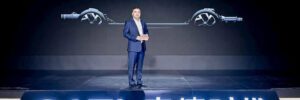CATL’s new Bedrock Chassis for EVs can withstand high impacts


Chinese battery manufacturer CATL has launched the CATL Bedrock Chassis, a skateboard chassis that can withstand 120 km/h frontal impacts without catching fire or exploding.
The battery-centered design uses cell-to-chassis integration technology, which directly integrates the battery cells into the chassis and allows for a shared structural design. Based on the decoupling of the chassis from the upper body, the Bedrock Chassis can absorb 85% of the vehicle’s collision energy, compared to around 60% absorbed by traditional chassis, according to the company.
The speed for frontal impact safety tests in the commonly used China New Car Assessment Program (C-NCAP) is 56 km/h, which, when experiencing a frontal impact at this speed, generates collision energy equivalent to falling from a 12-meter-high building. In comparison, a frontal impact at 120 km/h generates a collision energy 4.6 times that of collision at 56 km/h.
The Bedrock Chassis incorporates three core characteristics: internal integration; decoupling of the chassis from the upper body; and external openness. It offers a scalable software and hardware architecture and standardized interfaces, enabling flexible configurations for different vehicle models and scenarios. This enables a “one chassis architecture, multiple vehicle models” concept to improve development efficiency and shorten the R&D cycle.
The CATL Bedrock Chassis introduces a three-dimensional biomimetic tortoise-shell structure—the body and energy unit framework are integrated to protect the energy unit. Its aircraft carrier-grade arresting structure disperses impact forces across multiple pathways during a crash, gradually decelerating the vehicle and significantly reducing the depth and speed at which obstacles intrude the cabin. The utilization of submarine-grade hot-formed steel with a strength of 2,000 MPa, aerospace-grade aluminum alloy with a strength of 600 MPa and multiple barrier structures further enhance the rigidity of the chassis.
The chassis instantly disconnects its high-voltage circuit within 0.01 seconds of impact and completes the discharge of residual high-voltage energy in the vehicle within 0.2 seconds. The battery cells have undergone tests including high-speed sled impact tests at 60 km/h, 90-degree bending tests and sawing tests.
“The fourth-generation Cell-to-Chassis (CTC) technology and inverted battery cell technology enhance the utilization of chassis space while reducing the risk of chassis scraping. Additionally, in terms of intelligence, the chassis supports mechanical decoupling, software decoupling and EE decoupling, enabling L3 to L4 intelligent driving capabilities,” CATL stated.
Source: CATL




